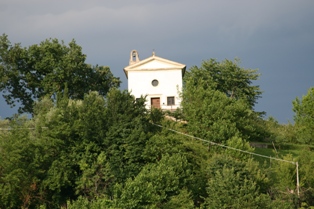
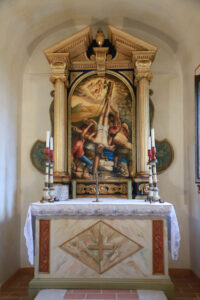
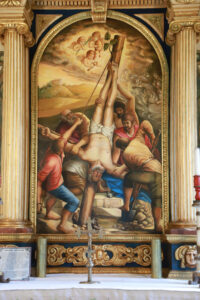
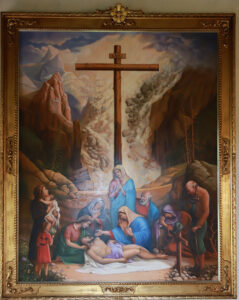
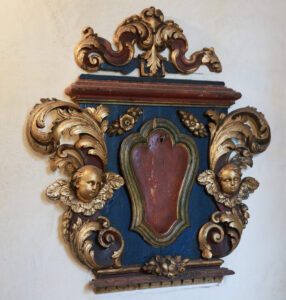
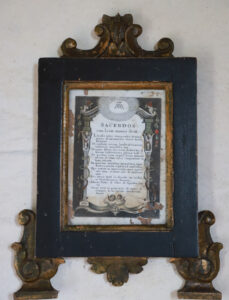
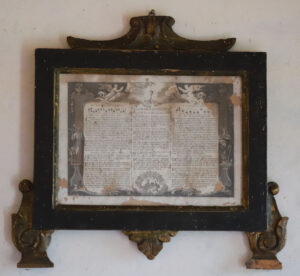

SAN PIETRO
La chiesa di San Pietro in località Rive risulta essere uno degli edifici di culto più antichi nel territorio della parrocchia di Tarzo.
La prima testimonianza risale al 25 ottobre 1377 con il toponimo di “Castel San Pietro” sembra quindi essere originariamente un luogo religioso strettamente legato a strutture o ambienti militari; dove il 23 gennaio dell’anno successivo ha un piccolo beneficio. Passò poi ad essere un chiericato: “chiericato di San Pietro”.
Da un documento dell’archivio diocesano risulta che nel 1418 tale beneficio di San Pietro viene unito a quello di San Martino di Fratta, i quali nel 1580 finiscono entrambi legati ai canonici della Cattedrale Santa Maria Assunta e Tiziano di Ceneda.
Nel 1492 la Chiesa subisce degli interventi di rifacimento, questo è facilmente desumibile visto che tale data è scolpita nella pietra sull’angolo sinistro della facciata ad altezza d’uomo, emersa durante i recenti lavori di restauro.
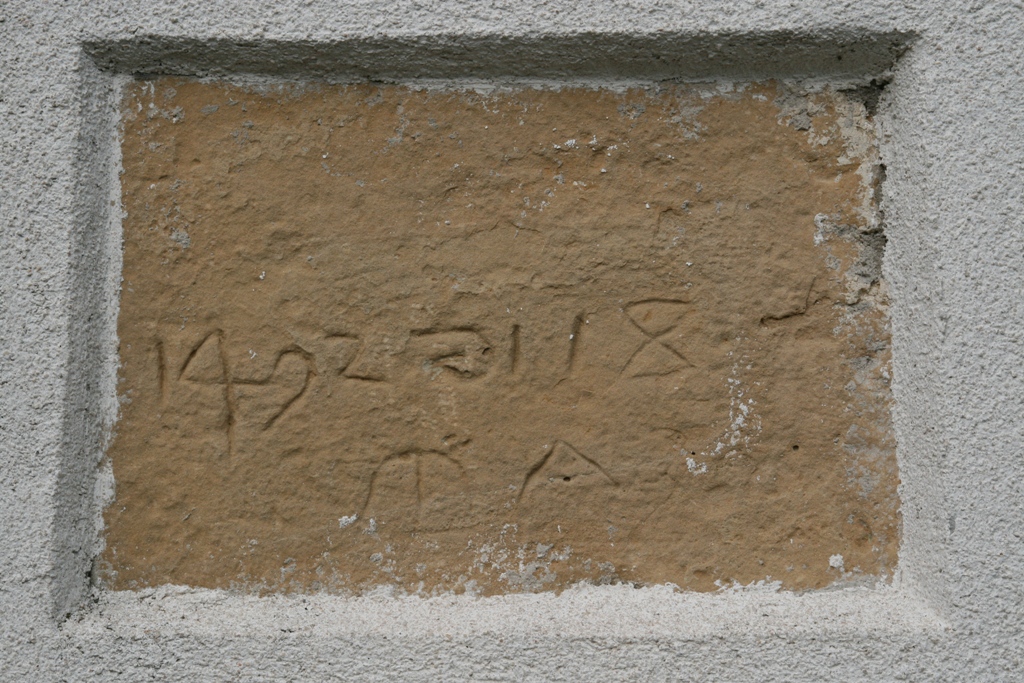
Altre notizie ci portano ad affermare che nel 1546 la Chiesa è vacante da molto tempo “per desolazione” e ufficiata dal chierico cenedese Stefano de Lucis. Nel 1550 è presente il sacerdote Filippo Quintino che vi rimase fino alla morte, mentre dal 1564 è con Giovanni Battista Brocca, chierico di Serravalle.
Qualche secolo dopo, durante la visita pastorale del 1736 viene descritta praticamente con queste parole: “Senza entrate e mantenuta con le elemosine dei fedeli”.
La stessa situazione viene pure riportata in una relazione del 1741: “Vi è poi la chiesetta campestre sotto il titolo di San Pietro, la quale non ha alcuna entrata; vive di elemosine e si mantiene al possibile dalla fabbriceria”.
Lo stesso anno la Chiesa risulta ristrutturata: lo troviamo in una dicitura visibile al suo interno sopra l’arco centrale fra due affreschi che così dice: “Nel 1741 questa Chiesa antica di San Pietro fu innalzata e ridotta a miglior forma con le elemosine del popolo”.
Nel 1744 il pittore cisonese Egidio Dall’Oglio dipinse la pala dell’altare (olio su tela) raffigurante “La Madonna con il Bambino, San Pietro, San Lorenzo e San Francesco”. Attualmente deposta nella sacrestia della chiesa parrocchiale, dopo il restauro con il concorso della sovrintendenza delle belle arti di Venezia.
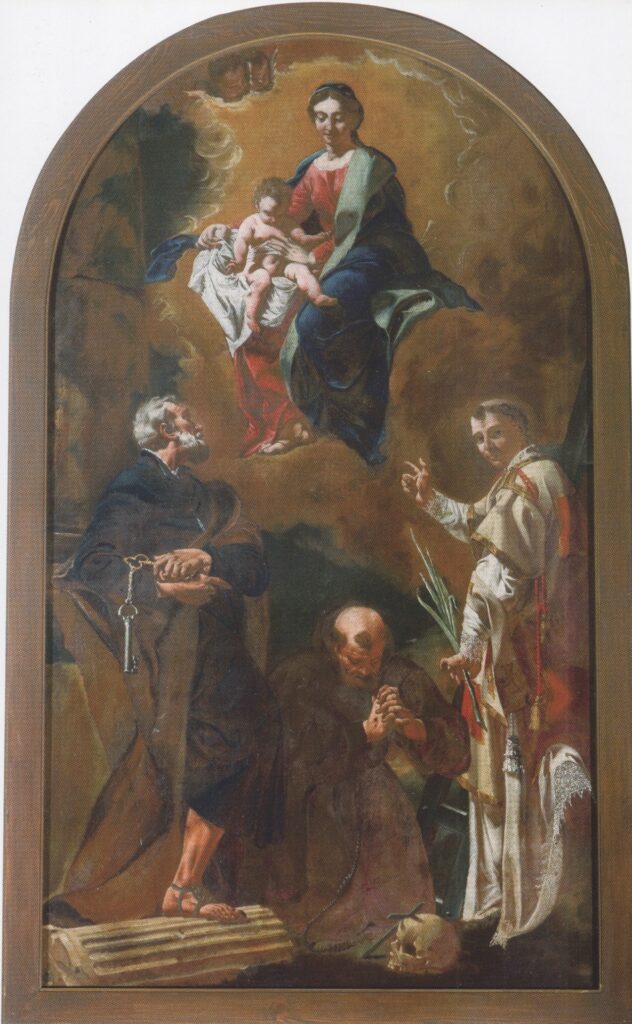
Nel 1969 il locale Gruppo della Associazione Nazionale Alpini, visto l’ormai avanzato degrado volle sistemarla: “Ridandole il suo religioso decoro, rivestendola di tanta grazia senza disturbare la sua primitiva semplicità, facendone quasi la loro chiesetta alpina”.
Nel 1983 e successivamente nel 1985-1986, gli Alpini con il concorso di simpatizzanti e volontari intervennero nuovamente con un restauro radicale, che interessò non solo le strutture perimetrali, ma anche il tetto ormai fatiscente al punto da comprometterne la stabilità.
E così il 22 giugno 1986, fra una grande partecipazione di popolo l’opera poté essere ufficialmente inaugurata, all’insegna della semplicità, dell’ordine e della simpatia.
La nuova pala dell’altare che rappresenta il martirio dell’apostolo Pietro, fu dono dell’autore locale Antonio Bernardi, il quale il 15 ottobre del 1988 arricchì la Chiesa donando un’altra sua opera pittorica raffigurante “la deposizione dalla Croce”.
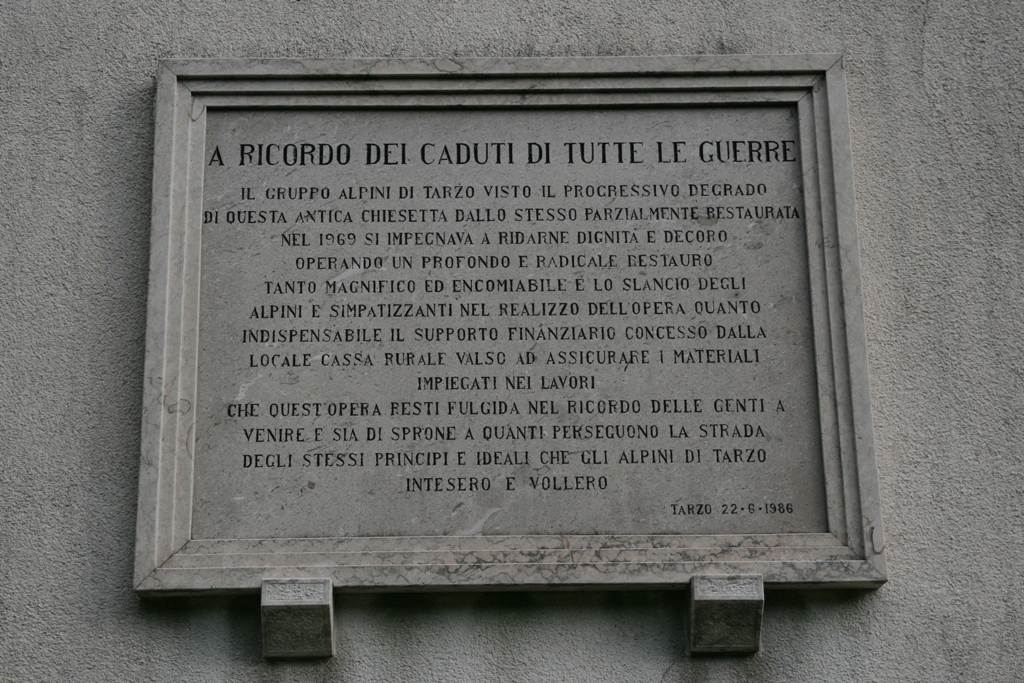
Il Gruppo Alpini di Tarzo, il quale vigila sulla sacralità e sul decoro della chiesa, volle ricordare ai posteri il suo impegno nella ristrutturazione, murando una lapide rievocativa sul lato esterno della parete Nord, e inumando una pergamena nell’area interna dell’apside.

SAN PIETRO
The church of Saint Peter on the Rive road is one of the oldest buildings of worship on the lands of the Tarzo parish.
Initial proof of its existence dates back to October 25th 1377, named St. Peter’s Castle. It seems therefore that it was originally a place of worship closely bound to military structures. On January 23rd of the following year it came to be called Chiericato di San Pietro, thus receiving an upgrade.
A document preserved in the diocese archives proves that in 1418 that upgrade was united with the one of Saint Martin chapel in Fratta. Both of them were tied to the canons of the Cathedral of Holy Assumption and Titian of Ceneda in 1580.
In 1492 the church underwent restoration work, an easily inferrable fact, since said date emerged during recent renovation operations and is engraved on the left corner of the facade, at man’s height.
There is some proof that allows us to state that the church had been vacant for a long time in 1546 due to lack of use: this has been officialized by local clergyman Stefano de Lucis. In 1550 father Filippo Quintino was the priest of the church, where he would stay until his death. In 1564 Giovanni Battista Brocca, a local clergyman, became the priest of the church.
Some centuries after that, during the pastoral visit of 1736, the church was described as: “Basically without income and maintained with the offering of the faithful”.
The same situation was reported in 1741: “Then there is the rural church of Saint Peter, which has no income; it lives off of charity and is maintained by the fabbriceria” (an institution for the maintenance of religious buildings that exists in some catholic countries).
In the same year the church is proven to have been renovated. We can find this information on a caption located above the central arch between two frescoes that says: “In 1741 this ancient church of Saint Peter was improved thanks to the charity of the people”.
In 1744 Egidio Dall’Oglio, a painter born in the nearby village of Cison, painted the altarpiece, an oil on canvas, that portrays Virgin Mary with Baby Jesus and Saints Peter, Lawrence and Francis. The altarpiece has been restored with the superintendence of the Venetian Academy of Fine Arts and is currently stored in the sacristy of the church.
In 1969 the local group of the Alpini National Association decided to fix it, because of its high degree of degradation, restoring its “religious decorum, coating it in much grace, however without violating its primitive simplicity, making it their little alpine church”.
In 1983 and after that in 1985-86 the Alpini radically operated on the church again, with the help of supporters and volunteers. This time the restoration didn’t only affect the perimetral structures, but also the roof, which was so degraded it was compromising the stability of the entire structure.
Thus, on June 22nd 1986, with a large crowd attending, the church was inaugurated with great simplicity and elegance.
The new altarpiece, which depicts the martyr of Peter The Apostle, was donated by local painter Antonio Bernardi, who, on October 15th 1988 further enriched the church by donating another work depicting the Deposition of Christ.

The Tarzo Alpini Group, that monitors the sacredness and decorum of the church wanted to remind posterity about their efforts to renovate the church by walling a remembrance headstone on the external side of the northern wall and burying a scroll in the internal part of the apse.
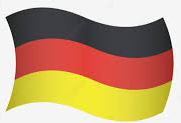
SAN PIETRO
Die Kirche San Pietro in Rive ist eines der ältesten Gotteshäuser auf dem Gebiet der Pfarrei von Tarzo. Das erste Zeugnis stammt vom 25. Oktober 1377 mit dem Namen “Castel San Pietro” scheint also ursprünglich ein religiöser Ort zu sein, der eng mit militärischen Strukturen oder Umgebungen verbunden ist; wo er am 23. Januar des folgenden Jahres einen kleinen Nutzen hat. Dann wurde er Kleriker: “Kleriker von St. Peter”.
Aus einem Dokument des diözesanen Archivs geht hervor, dass 1418 dieser Nutzen von San Pietro mit dem von San Martino di Fratta verbunden wurde, die beide 1580 an die Kanoniker der Kathedrale Santa Maria Assunta und Tiziano di Ceneda gebunden wurden.
Im Jahre 1492 wurde die Kirche restauriert, dies ist leicht erkennbar, weil dieses Datum in den Stein in der linken Ecke der Fassade in Höhe von Menschen geschnitzt ist, und wurde während der letzten Restaurierungsarbeiten gefunden.
Andere Nachrichten lassen uns behaupten, dass die Kirche im Jahr 1546 “durch Trostlosigkeit” vakant ist und vom Kleriker Stefano de Lucis von Ceneda gefeiert wird.
Im Jahr 1550 ist der Priester Filippo Quintino anwesend, der dort bis zu seinem Tod blieb, während seit 1564 Giovanni Battista Brocca, Kleriker von Serravalle.
Einige Jahrhunderte später, während des Pastoralbesuchs im Jahr 1736, wird er mit den Worten “Ohne Einkommen und mit den Almosen der Gläubigen gehalten” beschrieben.
Die gleiche Situation wird auch in einem Bericht aus dem Jahr 1741 berichtet: “Es gibt dann die kleine Landkirche unter dem Titel St. Peter, die kein Einkommen hat; Sie lebt von Almosen und hält sich so viel wie möglich von der “fabbriceria” (Einrichtung, die sich zur Erhaltung der Güter der heiligen Stätten verpflichtet).
Im selben Jahr wurde die Kirche restauriert: wir finden sie in einem Schriftzug, der im Inneren über dem zentralen Bogen zwischen zwei Fresken sichtbar ist. Die Schrift sagt: “Im Jahr 1741 wurde diese alte Kirche von San Pietro mit den Almosen des Volkes errichtet und auf eine bessere Form reduziert”.
Im Jahr 1744 malte der cisonesische Maler Egidio Dall’Oglio das Altarbild (Öl auf Leinwand), das “Die Madonna mit dem Kind, St. Peter, St. Laurentius und St. Francis” darstellt. Derzeit in der Sakristei der Pfarrkirche, nach der Restaurierung mit Hilfe der Aufsicht der Schönen Künste von Venedig gelegt.
Im Jahr 1969 wollte die lokale Gruppe des Nationalen Alpenvereins, angesichts des fortgeschrittenen Verfalls, sie reparieren: “Sie gab ihr ihre religiöse Dekoration zurück und kleidete sie mit so viel Anmut, ohne ihre ursprüngliche Einfachheit zu stören, und machte sie fast zu ihrer Alpenkirche”.
In den Jahren 1983 und 1985-1986, mit dem Wettbewerb von Sympathisanten und Freiwilligen, intervenierten die Alpenbewohner erneut mit einer radikalen Restaurierung, die nicht nur die Außenanlagen betraf, sondern auch das inzwischen baufällige Dach, das die Stabilität gefährdete.
Und so wurde das Werk am 22. Juni 1986 dank einer großen Beteiligung des Volkes im Zeichen der Einfachheit, der Ordnung und der Sympathie offiziell eingeweiht.
Das neue Altarbild, das das Martyrium des Apostels Petrus darstellt, war ein Geschenk des lokalen Autors Antonio Bernardi, der am 15. Oktober 1988 die Kirche bereicherte, indem er ein weiteres Bildwerk schenkte, das “die Kreuzabnahme” darstellt.
Die Alpini-Gruppe von Tarzo, die über die Sakralität und die Dekoration der Kirche wacht, wollte die Nachwelt an ihr Engagement für die Renovierung erinnern, indem sie eine Gedenktafel an der Außenseite der Nordwand anbringte und ein Pergament im inneren Bereich der Apsis.